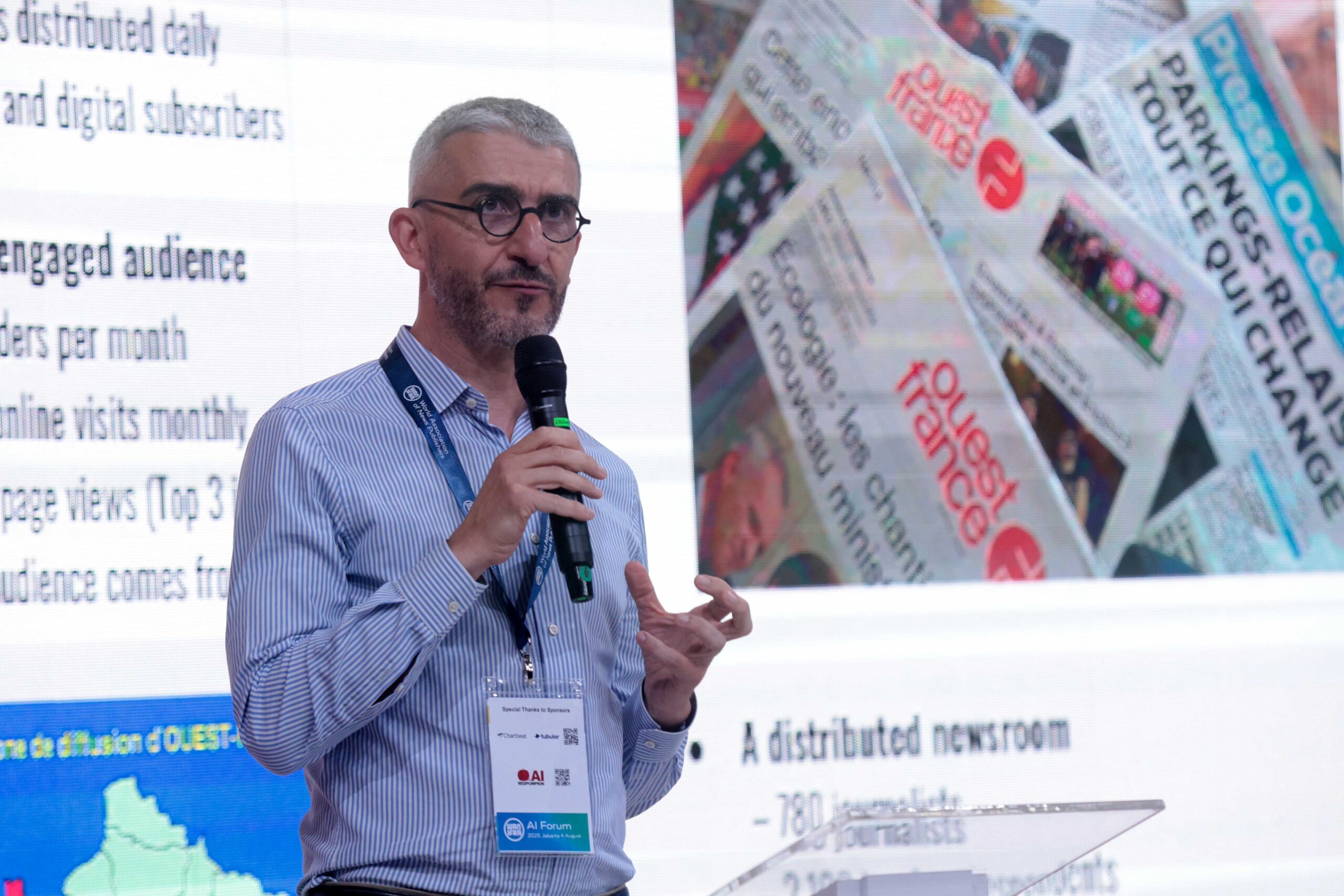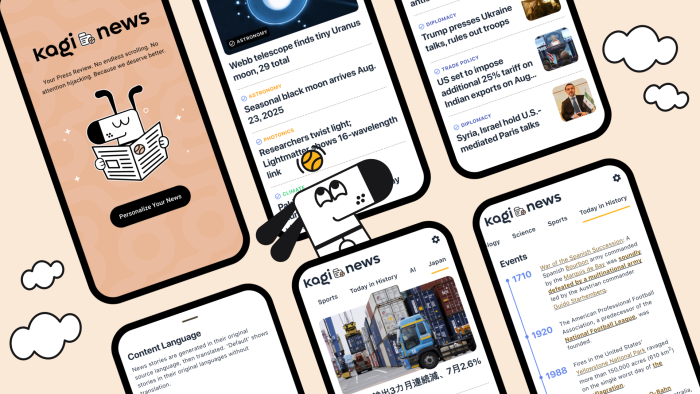When generative AI exploded onto the scene, Ouest-France was well-placed to take advantage of the new technology thanks to its long history of working with AI.
Already before the current buzz around the tech, the French publisher’s dozen or so data scientists and engineers had been using AI for a while, for example when working on the digitalisation of the company’s archives, said David Dieudonné, Head of AI at Ouest-France.
Ouest-France is France’s top newspaper by paid circulation, with 480,000 print and digital subscribers. The title, founded in 1944 and mostly circulated in the west of the country, has a sizable network of 780 journalists. In September, it expanded to broadcasting with the launch of a new TV channel in France.
Read more: Ouest-France bets on TV to diversify revenue streams
The publisher’s experience with AI gave it a “luxury of approaching AI in a very principled way,” Dieudonné said during his presentation at WAN-IFRA’s Jakarta AI Forum 2025. A key part of this was a commitment to investing in internal AI expertise and tech capacities.
More specifically, Ouest-France’s principles for the use of AI include:
Putting AI at the service of the mission. The aim is for AI to be “not something we work for, but something that works for us, especially the newsroom,” Dieudonné said.
Ensuring a secure tech environment. Protecting data and copyright is paramount, including protecting journalists’ work from being used as training data by AI platforms, Dieudonné said: “We block crawlers, and we are very protective of the content, making sure it’s not circulated in data centres that are not in our control.”
Human in the loop. In principle, every piece of AI-generated content is verified by staff before publishing. However, the company is identifying exceptions to this rule, such as weather forecasts and other comparable use cases.
Transparency. Being open with the audience about the use of AI is critical, as is transparency about correcting possible mistakes.
Maintaining employment. The publisher is committed to designing AI solutions without disrupting the newsroom organisation, as well as having a commitment to upskilling and mobility.
Notably, Ouest-France has opted out of making deals with AI platforms, unlike some publishers who have entered into such arrangements. Instead, Ouest-France collaborates with public research institutions, and has announced a partnership with the French state research organisation and the University of Rennes to explore the use of AI in journalism.
David Dieudonné will be speaking at WAN-IFRA’s Paris AI Forum 2025 on 28–29 October 2025 about Ouest-France’s AI strategy.
Building a protected environment for AI use
Ouest-France’s AI strategy is guided by a vision of AI as a “double opportunity,” Dieudonné said.
AI can foster editorial excellence by assisting journalists with repetitive, low-value tasks and allowing them to spend more time with on-the-ground sources and detecting signals in complicated datasets.
Editorial gains go hand-in-hand with economic efficiency. AI can help increase engagement through a diversification of formats (text-to-audio, text-to-video), the generation of new engaging features (such as quizzes) and increased personalisation, for example through chatbots.
Aligning with Ouest-France’s aim to build a secure tech environment, the company has created a “protected” technical foundation for its employees to use AI, Dieudonné said.
“We built a sandbox that allows every journalist, but also people working in other departments, to have safe access to LLMs, but in a way that there is no transfer of data. So they can put their story in the sandbox and modify it without compromising the copyright of their content,” he said.
Dieudonné acknowledged that although building this infrastructure took some time, a more time-consuming step is actually “training people so that they have access to this sandbox and know how to optimise it.” This has included roadshows that travel from city to city to train journalists on its use.
Process for ‘bottom-up’ AI innovation
The AI sandbox was also designed to guarantee “experimentation that comes from the bottom to the top of the company,” Dieudonné said.
Rather than deciding on use cases in advance, “the idea was to really see which use cases were the most relevant for journalists on the ground, which were the problems they needed to solve, and how LLMs could do that.”
Using the sandbox, Ouest-France’s journalists created 30 prototypes for possible use cases.
“That became the new problem,” Dieudonné said. “When you have such an appetite for creating solutions and creating prototypes, how do you evaluate them so that they can be scaled across the organization?”
Ultimately the company created a three-step process for evaluating AI development opportunities.
First, prototypes are evaluated at a team level by the teams involved. For instance, one prototype that was about tagging content was checked by journalists who would use it, as well as HR and legal departments for potential organisational impacts or copyright issues.
After this step, AI prototypes go to the executive committee for the management to have its say, especially in terms of prioritisation. Here, the main criteria is return on investment: making sure that the new tool doesn’t cost more money than it can create value.
Finally, prototypes are presented to the employee representatives. The goal is to “make sure we have a consensus, and I think building this consensus within the organization is part of the experiment,” Dieudonné said.
Learnings, control and monetisation potential
To maximise the impact of its new AI tools, the publisher has so far validated only a few prototypes.
Some of these have been for similar use cases that many publishers are adopting AI for, such as improved tagging and AI-generated article summaries. Another new tool can transform an article into a quiz.
 Ouest-France also developed a chatbot dedicated to the sports car race 24 Heures du Mans.
Ouest-France also developed a chatbot dedicated to the sports car race 24 Heures du Mans.
“It was the first time a media [company] did that in France,” Dieudonné said. “And maybe most importantly, we did it by ourselves.”
Using the company’s own resources for building the chatbot was a very informative experience, he said, in terms of learning about AI’s impact on SEO, as well as being fully in control of the user experience.
“You get to decide how your content is displayed [in the chatbot], and that generates a click-through rate that is in our experience superior to the one that you get through ChatGPT,” Dieudonné said.
More generally, publishers’ own chatbots could potentially be monetised through premium subscriptions or sponsorships, he added. However, Ouest-France did not seek to monetise its chatbot experiment.
“There’s still business value in it, as you’re learning how this technology functions. You’re better off in how you approach the conversation with AI platforms. So in that regard, I think there is value per se.”
Six responses to ‘disintermediation’
Dieudonné concluded by discussing AI’s impact on publishers’ business models, and specifically the risk of “disintermediation,” which would see publishers losing control of the relationship with their audience.
He listed six key responses to this threat:
Reinvest in core journalism: High-value reporting is “what makes us different, what makes us unique,” and it provides value “that these platforms are not going to produce.”
Optimise for machines and humans: Publishers should anticipate dual audiences, and content should perform well with algorithms (SEO, voice assistants) while also being compelling for readers.
Adapt to emerging use cases: Embrace new modes of news consumption (chatbots, voice), but crucially, also plan safeguards around editorial integrity and human oversight.
Double down on local and community: Driven by scale, AI platforms “tend to be less efficient on the ‘last mile,’ which is hyperlocal news. Which is an area where we are good at,” Dieudonné said.
Educate and influence: The news industry should aim to build awareness with the audience, regulators and other stakeholders about the impact of disintermediation, he said. “We are very familiar with these themes, but neither the audience nor regulators sometimes have this knowledge.”
Collaborate for strength: Join forces with others in the industry to build resilience and influence.



